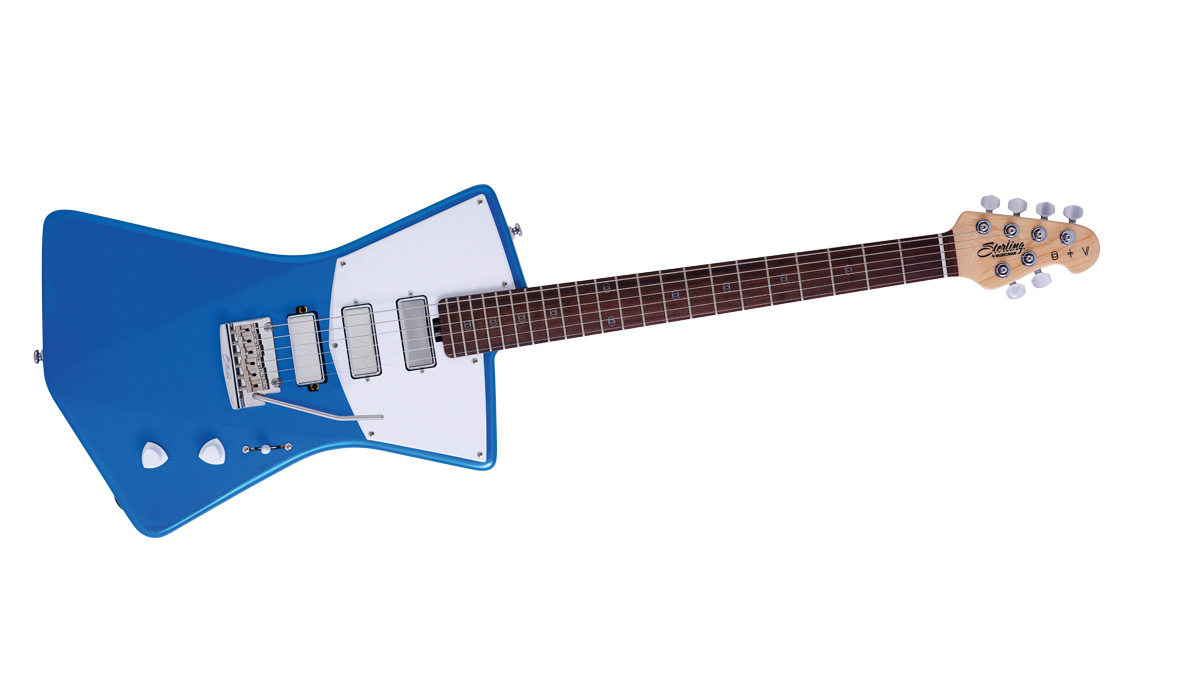MusicRadar Verdict
A very showy piece - but well priced and fit for purpose. So are you brave enough to take it for a spin?
Pros
- +
Visionary design with a powerful voice.
- +
Good build and surprisingly ergonomic.
Cons
- -
Pickup voicing and switch options not for everyone.
- -
Push-in vibrato arm needed some attention.
MusicRadar's got your back
Music Man’s St Vincent electric guitar appeared last year, and this hugely individualistic statement designed by Annie Clark (aka St Vincent) might well have been conceived to better fit the female form, but it has the sort of cool that should appeal to chaps, too.
At the start of this year, Music Man announced an Indonesian-made Sterling version of the instrument at a third of the price, on review here.
The St Vincent, aside from its shape, goes for a Fender-ish recipe with a 648mm (25.5-inch) scale, a trio of pickups and a five-screw bolt-on maple neck on a rather non-Fender mahogany body. From the base of the body to the tip of the headstock the guitar covers around 1,016mm (40 inches), which is about 38mm longer than a Stratocaster.
The St Vincent’s angular body with its distinct chamfering is around 41mm at its centre, and tapers down to 26mm at the tip of the bass-side lower bout. The St Vincent employs a version of Music Man’s ‘vintage’ two-post vibrato, placed flat on the body with no upbend, bent-steel saddles and a die-cast block. There is also a Gibson 305mm (12-inch) radius’d fingerboard.
Sounds
Strapped on, the St Vincent is very slightly neck-heavy. After playing time, though, it doesn’t feels particularly odd. More unusual is the St Vincent’s pickup and control setup.
The trio of mini-humbuckers apes the custom-wound DiMarzios of the USA version (though these have a huge DC ohm reading that suggests a thinner wire gauge), while the five-way lever switch offers us, from position one, bridge, middle, neck, all three (in parallel), plus - where we’d expect the neck pickup selection to be – neck and bridge, again in parallel.
This is a guitar that likes gain and can really soar
As we expect, the St Vincent offers a thick voice that adds noticeable hair to our previously clean test amps: juicy and fruity on the solo pickup positions, with some welcome hollowness from the neck and bridge position, likewise all three, which actually adds a little Stratty-ness.
Want all the hottest music and gear news, reviews, deals, features and more, direct to your inbox? Sign up here.
This is a guitar that likes gain and can really soar, although the mix positions add plenty of currency for more textural, funkier voices. The St Vincent has an odd arrangement for its vibrato arm: once we pushed it in, we couldn’t get it out again.
Well, if you’re looking for something a little leftfield, this is certainly that. The St Vincent certainly packs a sonic punch and proved quite a driver for our pedalboard and Helix LT. It’s out-there looking, but the more we play it, that shape is surprisingly comfortable.
Dave Burrluck is one of the world’s most experienced guitar journalists, who started writing back in the '80s for International Musician and Recording World, co-founded The Guitar Magazine and has been the Gear Reviews Editor of Guitarist magazine for the past two decades. Along the way, Dave has been the sole author of The PRS Guitar Book and The Player's Guide to Guitar Maintenance as well as contributing to numerous other books on the electric guitar. Dave is an active gigging and recording musician and still finds time to make, repair and mod guitars, not least for Guitarist’s The Mod Squad.

